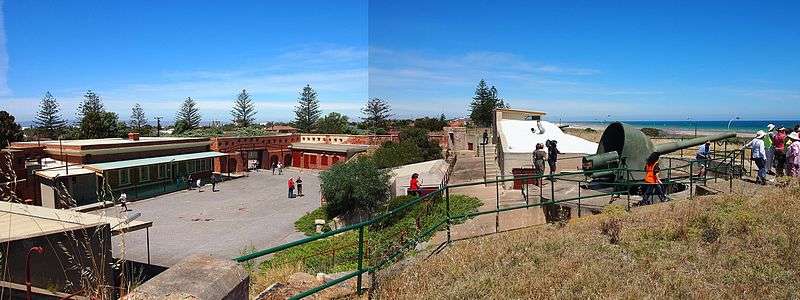Fort Largs
Coordinates: 34°48′36″S 138°29′38″E / 34.810086°S 138.493824°E Fort Largs is a historic defence site in the seaside suburb of Taperoo near Port Adelaide, approximately 18 km (11 mi) north west of Adelaide's centre. In the 1960s it was repurposed for use as the South Australian Police Academy. In 2012, new police academy housing was constructed on the east portion of the site and, as of 2014, the west portion of the site, including the historic defence constructions, was slated for redevelopment.
In June 2016 Renewal SA announced its preferred tenderer, AVJennings, for the redevelopment of part of the site for about 250 homes, with the heritage-listed WW II barracks to be converted to apartments, the Drill Hall to be retained as a community facility, and the historic fort to be owned and operated by the National Trust of SA.[1]
Fort
In the late 1800s, visits of Russian ships in South Australian waters were of a friendly nature, but the Russo-Turkish War of 1877–1878 was seen by Britain as part of a potential expansion plan by the Russian Empire into India, and the Australian colonies were advised to upgrade their defence capabilities. The inadequacy of defences in the colony was seen in 1862, when the Svetlana sailed into Port Phillip Bay (Melbourne) and the fort built had no gunpowder for its cannons to use to return a salute. William Jervois, a Royal Engineer, was commissioned to determine the defence capabilities of all colonies, with the exception of Western Australia. In his report, he was convinced that the Russian Empire would attack South Australian shipping in an attempt to destroy the local economy. As a result of Jervois' report, Fort Glanville and Fort Largs were built to protect Port Adelaide.[2][3][4]
Lieutenant Colonel Peter Scratchley was primarily responsible for the design of both Fort Largs and its nearby precursor Fort Glanville.[5] Work began in 1882 on what was first known as the Port Adelaide battery, to the same specification as Fort Glanville. Its barracks and rear defence wall were finished in 1885.[6] Emphasis for defence of the Adelaide coast had shifted to Fort Largs by 1888. In 1889, Fort Largs was equipped with two 6-inch breech-loading disappearing guns which outranged Glanville's armament.[7] Due to this and changes in the Port River and shipping movements, Fort Largs had surpassed Fort Glanville in strategic importance by 1890.[5]
In 1984, the fort was entered as a state heritage place in the South Australian Heritage Register.[8]

Barracks and drill hall
In May 1939 construction commenced on a two-storied brick barracks for the artillery units based at Fort Largs, plus a brick drill hall for use of the militia. The barracks incorporated a commercial kitchen and mess room, orderly room, canteen and billiard room, and administration rooms. When the police occupied Fort Largs in 1961 that same disposition was continued for several decades, although the barrack rooms were immediately adapted into classrooms for cadet training. In April 2015 the barracks and drill hall were entered as a state heritage place on the South Australian Heritage Register.[10]
Police academy
In the 1960s, a part of the original fort was adapted for use by the nearby South Australian Police academy which was known as Fort Largs Police Academy, the main training facility for South Australia Police. Parts of the academy site were put up for sale in 2009[11] and the construction of new police academy housing commenced on a portion of the site immediately east of the old fort. The old academy site has been disused since the 2012 opening of the new police academy.
Redevelopment
As of 2016, the Fort Largs site survives in slightly modified condition from its original state. Its underground tunnels, gun emplacements and storage areas are still largely original.[12] However, the site is slated for redevelopment as of 2014.[13] A May 2015 fact sheet produced by Renewal SA stated that the 7.4 hectares (18 acres) of land to be redeveloped is zoned residential, but any development must not "jeopardise the preservation and maintenance of the Fort, Barracks and Drill Hall", which are included in the site to be redeveloped.[13]
References
- ↑ Future of Fort Largs secured with AVJennings and National Trust partnership Renewal SA, 17 June 2016. Retrieved 17 June 2016.
- ↑ Protopopov (2006), A Russian Presence: A History of the Russian Church in Australia, p.8.
- ↑ Scanlon, Mike (19 July 2008). "Unorthodox Russians". The Newcastle Herald.
- ↑ Kroupnik, Vladimir. "The frigate "Svetlana" in Australia in 1862". Russia–Australia Historical Military Connections. Retrieved 2009-04-09.
- 1 2 NPWS (1988), p.55.
- ↑ NPWS (1988), p.58.
- ↑ NPWS (1988), p.59.
- ↑ "Fort Largs (including Rifled Muzzle Loading & Breech Loading Guns)". South Australian Heritage Register. Department of Environment, Water and Natural Resources. Retrieved 9 June 2016.
- ↑ History buffs protest sale of Fort Largs site in Adelaide ABC News, 25 October 2014. Retrieved 17 January 2015.
- ↑ "Fort Largs Barracks and Drill Hall". South Australian Heritage Register. Department of Environment, Water and Natural Resources. Retrieved 9 June 2016.
- ↑ "Police academy land for sale". 7 April 2009. Retrieved 18 January 2016.
- ↑ "Fort Largs". On Topic Media. 23 March 2014. Retrieved 18 January 2016.
- 1 2 "Sale of surplus land at Fort Largs former Police Academy, Taperoo" (PDF). Renewal SA, Government of South Australia. May 2015. Retrieved 18 January 2016.
Further reading
- National Parks and Wildlife Service (NPWS) (November 1988). Fort Glanville Conservation Park Management Plan (PDF). Department for Environment and Planning. ISBN 0-7243-9069-3. Retrieved 2009-01-22.
- Protopopov, Michael (2006). A Russian Presence: A History of the Russian Church in Australia. Gorgias Press LLC. ISBN 1-59333-321-8.